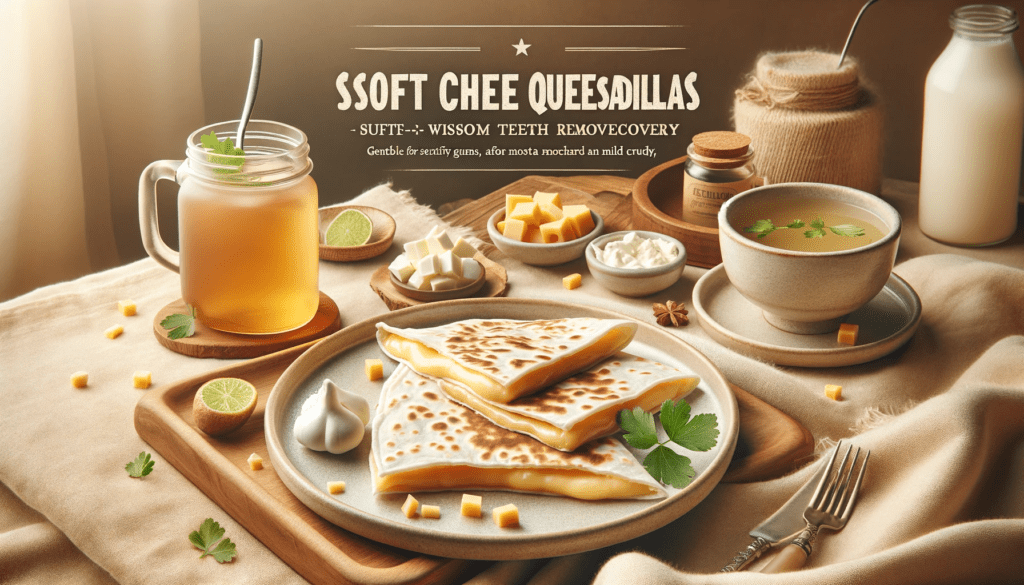After wisdom teeth removal, the journey to recovery involves careful consideration of your diet. Soft, easy-to-chew foods are recommended to prevent irritation and promote healing. A common question that arises during this period is whether it’s safe to indulge in certain comfort foods, like quesadillas.
This article delves into the considerations, timing, and ways to safely incorporate quesadillas into your post-surgery diet.
Understanding the Recovery Process
The journey after wisdom teeth removal can be unique for everyone, but the principles of care remain consistent. As someone who has navigated this path, I emphasize the importance of following professional advice during the recovery phase. Patience and adherence to recommended guidelines play a significant role in healing without complications.
Immediate Post-Surgery Guidelines
After your wisdom teeth extraction, the first 24 to 48 hours are crucial for your recovery. Your oral surgeon or dentist will likely advise you to adhere strictly to a liquid diet to avoid disturbing the blood clots at the surgery sites.
These initial days are not the time for solid foods like quesadillas, as they can disrupt the healing process. Instead, focus on soothing, nutrient-rich liquids and avoid anything that might jeopardize your recovery.
The Role of Nutrition in Healing
After undergoing wisdom teeth removal, the healing journey begins, where nutrition plays a pivotal role. As someone who has navigated this recovery process firsthand, I understand the importance of adhering to a balanced diet rich in vitamins, minerals, and proteins to aid in the healing. Post-surgery, the texture and temperature of the food you consume can significantly impact your comfort and the risk of complications.
Eating a quesadilla might seem like a comforting choice after surgery, but it’s essential to evaluate its texture and temperature. Soft, lukewarm foods are generally recommended to avoid irritating the surgical sites. While a quesadilla can be modified to meet these criteria, ensure it is not too hot, crispy, or stuffed with hard ingredients that could disrupt the healing process.
Incorporating a diet that supports recovery involves more than just selecting the right food; it’s about ensuring you receive the essential nutrients needed for healing. Although a quesadilla can be part of your post-surgery diet, remember to complement it with other nutrient-rich foods to foster optimal healing.
Incorporating Quesadillas Post-Wisdom Teeth Removal
Timing is Key
Introducing a quesadilla into your diet should be done with caution and only after the initial recovery phase, usually a week after the surgery, when you have started to eat semi-solid foods comfortably.
Choosing the Right Ingredients
- Soft Fillings: Opt for soft, non-chewy fillings like melted cheese and refried beans. Avoid adding crunchy vegetables or meats that require extensive chewing.
- Whole Wheat Tortillas: Consider using whole wheat or soft tortillas that are easier to chew and digest compared to their crispy, fried counterparts.

Preparation Tips
- Avoid Spicy and Hot Foods: Spices can irritate the extraction site, so keep your quesadilla mild.
- Cut into Small, Manageable Pieces: Smaller pieces are easier to chew and less likely to disrupt the healing sites.
Alternatives to Traditional Quesadillas
Soft-Cheese Quesadillas
After undergoing wisdom teeth removal, finding foods that are comforting yet safe for your healing gums is essential. One such gentle option is Soft-Cheese Quesadillas. These quesadillas swap out traditional, harder fillings for soft cheeses such as mozzarella and mild cheddar. These cheeses provide the comfort of a familiar food without the risk of irritating your sensitive areas.
In my own experience, after having my wisdom teeth removed, I found that sticking to softer textures was key in avoiding additional pain or complications. A quesadilla made with soft cheese allowed me to enjoy a tasty meal without the worry of harming my recovery process. Remember, the goal is to heal swiftly and without setbacks, so choosing the right type of food is crucial.

Pureed Quesadilla Filling
In the early stages of recovery from wisdom teeth removal, you might crave the warm, comforting flavor of a quesadilla but find traditional options too challenging to eat. I’ve found that pureeing the quesadilla filling offers a satisfying alternative. This method transforms your favorite ingredients into a smooth, delicious dip that’s gentle on healing mouths.
Pairing this with soft tortilla pieces allows for the enjoyment of the quesadilla essence without risking the recovery process. From personal experience, this adaptation doesn’t just soothe the craving but also adds a comforting, flavorful twist to the recovery diet.
Potential Risks and Complications
Dislodging the Blood Clot
After undergoing wisdom teeth removal, the temptation to indulge in a quesadilla can be strong, yet it’s essential to prioritize healing. Consuming chewy and solid foods like quesadillas can risk dislodging the blood clot formed in the extraction site, leading to severe complications such as dry socket.
This condition occurs when the crucial clot, which aids in the recovery post-surgery, is removed prematurely, exposing underlying nerves and bone. Based on personal experience and expertise, avoiding such foods to protect the clot is critical. Instead, opt for softer alternatives that don’t jeopardize your recovery, ensuring a smoother and faster healing process without unnecessary pain or setbacks.
Infection
After wisdom teeth extraction, it is essential to maintain strict oral hygiene practices to avoid complications. Consuming a quesadilla too soon can pose risks as food particles may become trapped in the extraction sites, increasing the chance of infection.
Based on personal experience, I recommend adhering to a diet of soft foods to ensure a smooth healing process and minimize the risk of irritating the sensitive areas. It’s better to be safe and delay indulging in complex foods to prevent any adverse effects on your recovery.
Check Also: Can I Swim After Wisdom Teeth Removal?
Frequently asked Questions
How soon can I eat solid food after wisdom teeth removal?
It varies by individual, but typically, solid food can be reintroduced into your diet 7 to 10 days after surgery. Start with soft, easy-to-chew foods and gradually move to more solid foods as your comfort allows.
Can I eat spicy foods after wisdom teeth removal?
It’s best to avoid spicy foods for at least a week or until your extraction sites have significantly healed, as spicy foods can irritate the wounds and delay healing.
When can I start drinking through a straw after my surgery?
Avoid using a straw for at least a week after your surgery because the suction can dislodge the blood clots that form in the extraction sites, leading to dry socket.
Is it normal to have swelling after wisdom teeth removal?
Yes, swelling is a normal part of the healing process. It usually peaks around the second or third day and then gradually subsides.
Can I drink alcohol after wisdom teeth removal?
You should avoid alcohol for at least 48 hours after surgery, or longer if you are taking prescription pain medications, as alcohol can interfere with the healing process and react adversely with medication.
What are the signs of infection after wisdom teeth removal?
Signs of infection include persistent pain, swelling that worsens after the first few days, yellow or white discharge from the extraction site, and a foul taste or smell in the mouth. If you experience any of these symptoms, contact your dentist immediately.
How do I clean my mouth after wisdom teeth removal?
Avoid brushing the extraction sites for the first day. Instead, gently rinse your mouth with warm salt water several times a day, especially after eating, to keep the area clean.
Can I eat dairy products after wisdom teeth removal?
Yes, dairy products like yogurt, pudding, and ice cream can be eaten after surgery. They are good sources of nutrition and can help soothe the extraction sites, but choose options with less sugar to avoid cavities.
Why is it important to avoid hard, chewy, or crunchy foods after surgery?
Hard, chewy, and crunchy foods can irritate the healing tissue, dislodge the blood clot, and introduce debris into the extraction sites, which can lead to infection or other complications.
How long does the healing process take after wisdom teeth removal?
While the initial healing phase typically lasts one to two weeks, the extraction sites may take up to six months to fully heal. However, most people can resume their normal activities within a week.
Conclusion
While a quesadilla might not be the first choice of food immediately after wisdom teeth removal, it can be incorporated into your diet during the later stages of recovery with some modifications. Always prioritize your comfort and follow the guidelines provided by your healthcare provider. When in doubt, opt for softer, less complex foods to ensure a smooth and swift healing process.
